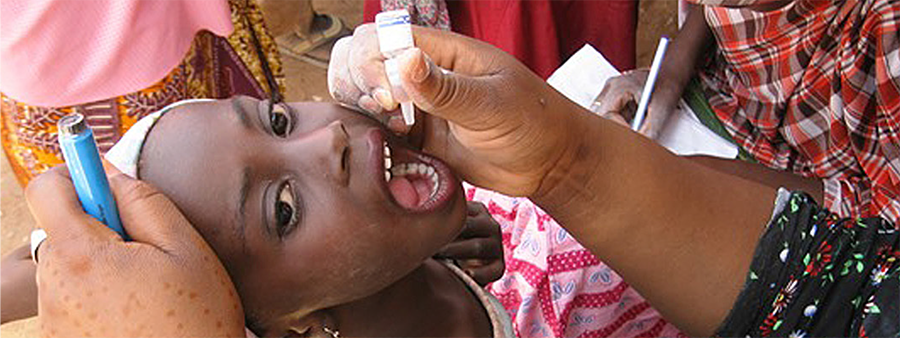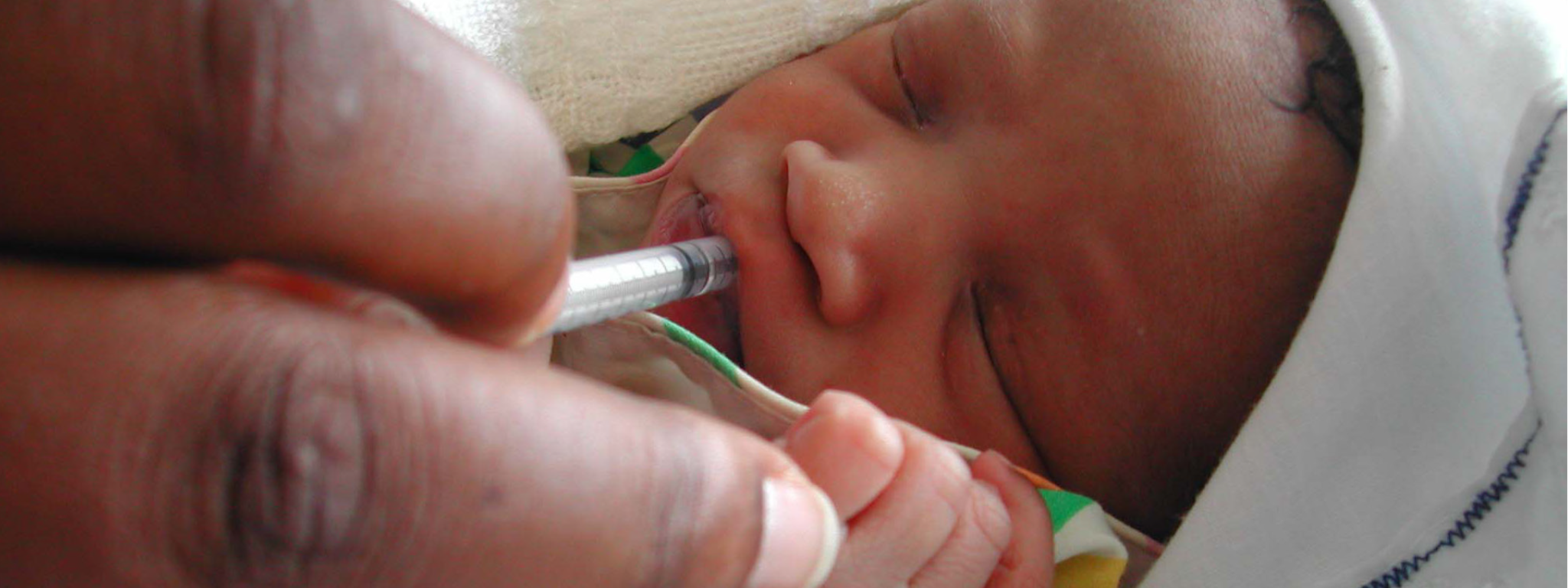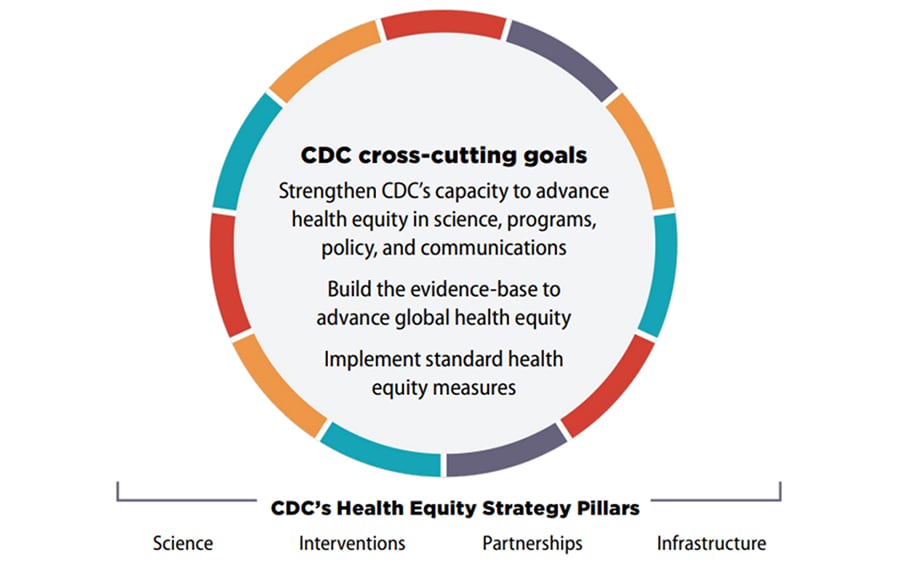CDC Global Program Goals, Indicators, and Milestones
In January 2021, the Global Health Center Health Equity Team, represented by members across GHC global programs, was formed and began a process to develop a HE strategy to address Goal 4: Strengthen GHC capacity to achieve health equity in science and programs [26]. At the outset of the CORE process, it was clear that the CORE goals should be linked to existing CIO strategies or science agendas. The initial draft goals developed by the GHC HE Team informed the development of the 3 CORE cross-cutting goals and division CORE goals. Ultimately, these CORE cross-cutting goals, described below, encompass and are inclusive of CDC’s global programmatic health equity goals.
Cross-cutting Goals
The 3 cross-cutting goals align with CDC’s health equity pillars: science, interventions, partnerships, and infrastructure, and the indicators and milestones address multiple CORE themes. These cross-cutting goals elevate CDC work in advancing evidence-based knowledge and implement standard health equity measures into our global data collection efforts for epidemics and accelerated disease control, eradication, and elimination among groups who have been economically and socially marginalized.
Cross-Cutting Goal 1 Indicators and Milestones
Cross-cutting Goal 1: By 2027, building on CDC’s core strengths in scientific leadership, innovation, surveillance, laboratory, and using data to drive impact, CDC will assess and strengthen our capacity, infrastructure, policies, and partnerships to consistently and deliberatively apply global health equity principles and approaches to our global health science, interventions, programs, policy development, and communication.

Indicators |
Milestones |
|---|---|
| 1.1 Percentage of eligible CDC global science and policy strategies/agendas (new and existing) that integrate health equity goals/objectives/principles [stratified by division, country, program, and overall CDC global programs]. | Determine the percentage of eligible CDC global science and policy strategies/agendas that incorporate health equity principles and approaches.
Integrate health equity and social determinants of health in all internal and external communications and policies. |
| 1.2 Number of CDC-supported global laboratory programs include health equity principles in their global laboratory capacity strengthening plan. | Guidance and requirements to integrate health equity principles in all CDC-supported global laboratory capacity strengthening plans will be developed and implemented. |
| 1.3 Number of partners identified and funded to implement activities that address social determinants of health aim to reduce health disparities and improve health equity among historically, socio-economically, and/or geographically disadvantaged/ discriminated populations. |
New and/or existing implementing partners will be identified and funded to implement activities to reduce health disparities among disadvantaged populations.
Work with WHO, PAHO, and other global partners, to develop and promote a comprehensive global health equity approach to includes principles, standards, and metrics to address the drivers/root causes of health disparities. |
| 1.4 Number of Notices of Funding Opportunity Announcements (NOFO) that explicitly address health equity and disparities and/or social determinants of health among populations who have been historically, socio-economically, or geographically disadvantaged. | Develop consensus funding opportunity requirements and evaluation criteria and increase the proportion of local indigenous and community-based implementing partners for all new global funding opportunities. |
Cross-Cutting Goal 2 Indicators and Milestones
Cross-cutting Goal 2: By 2027, build the evidence-based knowledge to advance health equity in our global health science and interventions.

Indicators |
Milestones |
| 2.1 Number of global research and non-research programs that include health equity goals. | By 2023, integrate HE activities and long-term goals into a framework, as part of the implementation plan, that prioritizes health equity research and evidence-building activities. |
| 2.2 Number of published papers that focus on global health equity, addressing issues beyond US border. | Develop an evidence-building and learning framework for global health equity strategy.
Disseminate significant results, reports, and best practices. |
Cross-Cutting Goal 3 Indicators and Milestones
Cross-cutting Goal 3: By 2027, implement standard health equity measures that will be seamlessly integrated into CDC global data collection efforts (surveys, surveillance, routine program, supply chain, laboratory) and used to reach epidemic and accelerated disease control, and disease eradication and elimination among known and unknown marginalized populations.

Provide informatics support to increase access to data including broadband, connectivity and integrated platforms
Indicators |
Milestones |
| 3.1 Data collection activities has <10% of existing health equity measures missing (Target: 80%, initially focused on DGHT data collection activity). | Develop core and expanded list of standard health equity measures with the flexibility to be tailored to the cultural and political context of each individual country
Provide training on data collection and sharing of health equity data from/with number of diverse stakeholders
Provide informatics support to increase access to data including broadband, connectivity and integrated platforms |
| 3.2 CDC-funded data collection with new, data-driven health equity indicators systematically reported to CDC (Target: 80%). | Identify number of new health related variables, including multilevel and contextual variables, to aid in identifying populations that are marginalized
Support policy and data collection optimization within CDC supported programs |
| 3.3 Percent of CDC-supported programs that use health equity measures and indicators to develop and improve global programming (target: 80%) | Develop and support standard analyses of newly developed health equity measures to inform the epidemiology and programmatic efforts of CDC programs
Ensure access, sharing, translation, and use of results of health equity analyses to improve program implementation and planning for marginalized populations |
CDC’s Global Program Goals, Indicators, and Milestones
The CORE initiative charged each CDC division to develop 1-2 high impact transformative goal(s) related to their programmatic responsibilities [2, 3]. As mentioned, the division goals must be linked to CDC health equity goals. They must address the four pillars: science, interventions, partnerships, and infrastructure. As a program, CDC’s global work concentrates on global public health impact, protecting people from global health threats and advancing science for global disease eradication, elimination, and control. CDC’s global work focuses on countries and populations that have been historically, socially, and economically disadvantaged. Many of our CDC colleagues live in, hail from, represent, and advance the perspectives of people living in low- and middle-income countries. Our staff strive to bring cultural humility, lived experiences, and cultural understanding of the social determinants of health that are critical to equitably improving health outcomes for the entire population. CDC’s global programs have maximized their global public health impact by closely focusing on outcomes in communities who are underserved and groups who have been socially, economically, and geographically displaced, including refugee, migrant, and immigrant populations, which differ according to country context. The CORE HE goals will help divisions systematically develop and implement activities to address health disparities and promote health equity. These goals, indicators, and milestones reflect program priorities and scientific evidence and may be subject to revisions as our understanding of health equity continues to evolve and develop. CDC’s global programs also developed health equity commitment statements based on their goals. Other CIOs may conduct additional global activities that reduce health disparities, which will also support the goals of CDC’s Global Health Equity Strategy and can be embedded in this strategy.

A young girl receiving oral polio drops on National Immunization Day in Northern Nigeria.
Global Immunization Division (GID)
Health Equity Statement: Implement a health equity approach to identify and reach underserved populations with immunity gaps in all CDC priority countries that supports measurable reductions in mortality and morbidity from targeted vaccine-preventable diseases (VPD).
GID Goal: By December 31, 2026, in all CDC priority countries, underserved populations with immunity gaps2 are identified and reached with vaccination services to achieve measurable reductions in mortality and morbidity from targeted VPDs.

2Underserved populations with immunity gaps who have disproportionately high risk for vaccine-preventable diseases (e.g., zero-dose children, populations affected by conflict, disaster and humanitarian crisis, nomadic populations, populations with gender related barriers to immunization, populations without access to recommended vaccines).
Division of Global Health Protection (DGHP)
Health Equity Statement: Integrate health equity into essential public health functions, increase representation in the workforce, and advance pandemic preparedness to more comprehensively prepare, detect, and respond to public health threats and improve health outcomes.
DGHP Goal 1: By 2025, CDC to work with the broader community of National Public Health Institutes (NPHI) to support defining and accelerating progress towards health equity goals and developing and adopting health equity strategies in support of the global health security goal to enhance essential public health workforce and functions.
DGHP Goal 2: By 2026, CDC and partners will address disparities in access to preventive health care by promoting primary health care principles through the global health security framework to integrate infectious diseases and other health threats prevention program planning and delivery, thereby reducing their synergistic impact during public health threats and improving our approach to pandemic preparedness.

Division of Global HIV & TB (DGHT)
Health Equity Statement: Reduce health inequities among people living with HIV and TB by promoting policies and enhancing programming in CDC-supported countries to reduce or eliminate stigma and discrimination among marginalized populations and by identifying and eliminating systematic gaps in data, health infrastructure, and human capital that inhibit DGHT’s ability to fulfill its mission.
DGHT Goal 1: Affirm and advance the role of health equity and an equitable, diverse, and inclusive workforce as core principles for the work of CDC through continuous improvement and monitoring by September 30, 2023.
DGHT Goal 2: Advance the reduction of stigma and discrimination (S&D) through the promotion of civil and human rights to improve the health outcomes of persons at risk of, or living with, HIV and/or TB infection in countries where CDC works by September 30, 2025.


A newborn in Kampala, Uganda, receiving an antiviral drug to prevent the mother-to-child transmission of HIV.
Division of Parasitic Diseases and Malaria (DPDM)
Health Equity Statement: Improve availability and access to disease prevention and treatment services in places at high risk for parasitic diseases worldwide with a focus on soil transmitted helminths and malaria.
DPDM Goal 1: Identify the primary social determinants of health that increase the risk for parasitic diseases in underserved US communities (by 2023), and develop/implement a strategy to increase awareness, promote access to disease prevention services, and increase use of prevention practices (by 2026) with a focus on soil-transmitted helminths (STH) and malaria.
DPDM Goal 2: By end of 2025, increase access to a package of community care3 by 30% in remote areas currently underserved by peripheral health facilities in three high-burden malaria countries where US President’s Malaria Initiative operates, as measured by a 30% increase in all cause consults for illness treated by CHWs, to address health services disparities, particularly in rural areas.

3 The package of community care includes integrated community case management (iCCM) of pneumonia, diarrhea, and malaria for children under 5 and access to diagnosis and treatment for acute febrile illness for all ages.

A mosquito drawing blood during human contact.
